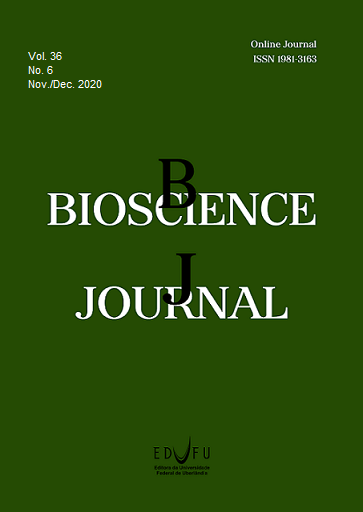Assessment and antimricrobial modulating activity of the extract of Baccharis cinerea DC. from cariri cearense
DOI:
https://doi.org/10.14393/BJ-v36n6a2020-42278Keywords:
Antibacterial activity, Modulation, Baccharis cinerea, phytochemicalAbstract
Baccharis cinerea belongs to the Asteraceae family, in Brazil is found in the Northeast and Southeast, occurring in the Caatinga and Mata Atlântica biomes, on the edges of the seasonal forests, board and altitude forests in both regenerating primary and secondary areas. Has proven antimicrobial and antiviral activity and is widely used in folk medicine for its various therapeutic effects and is used as an antiseptic for skin and wound infections, inflammation, diarrhea as well as being used as a purgative. The plants used in the traditional medicine are more and more explored scientifically because they are possible resources of substances with antimicrobial activity in front damage man’s health microorganism. In this context the objective of the study was to investigate the antimicrobial activity, modulator activity of antibiotic and in vitro phytochemical prospection of leaf ethanol extracts. Tests were performed on the bacterial strains of Staphylococcus aureus (ATCC 25923), Pseudomonas aeruginosa (ATCC 15442) and Escherichia coli (ATCC 10536). The antibacterial activity was analyzed by means determining the Minimum Inhibitory Concentration (MIC). For the evaluation of the modulating activity, the microdilution method of the diluted extract samples with the antibiotic’s amikacin, clindamycin and gentamicin was used. The MIC results were ≥ 1024 μg mL-1 by the bacterial strains. There was a relevance of concentrations in modulation with the antimicrobials tested such as amikacin and gentamicin, there were no discrepancy of clindamycin results in association with the extract. The chemical constituents found were leucoanthocyanidins, flabobenic tannins, flavanones, flavones, flavonoids, xanthones, chalcones, aurones. It is important to note that is necessary to do other studies to evaluate the potential of this species because it has important chemical compounds in reducing antimicrobial resistance.
Downloads
Published
Issue
Section
License
Copyright (c) 2020 Cleberton Torres Santos, Luiz Eduardo Oliveira Teotônio, Ana Paula Leite Nascimento, Darcio Luiz de Sousa Júnior, Ítalo Mykaell da Silva Benjamin, Cícera Natalia Figueiredo Leite Gondim, Henrique Douglas Melo Coutinho, Nadghia Figueiredo Leite

This work is licensed under a Creative Commons Attribution 4.0 International License.





